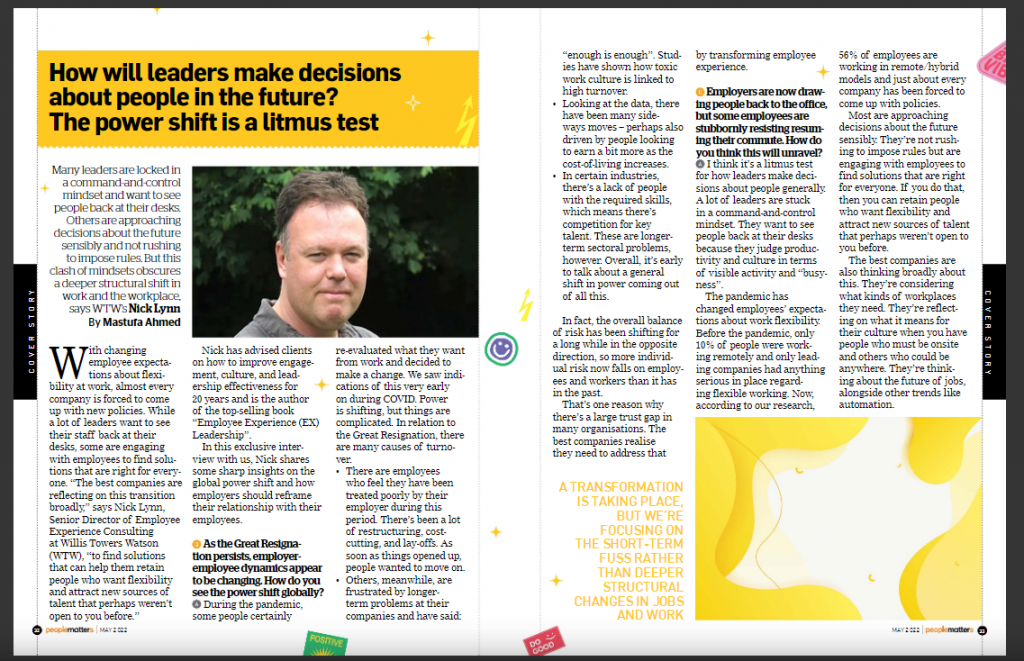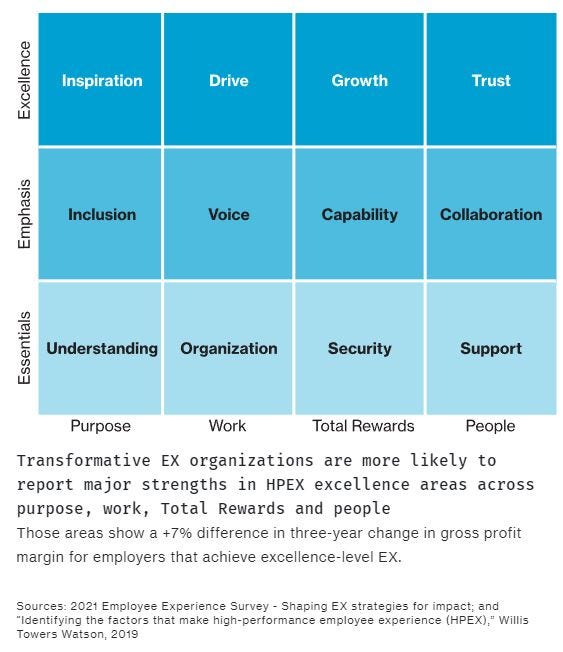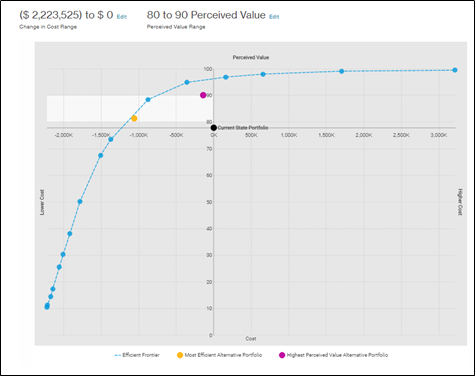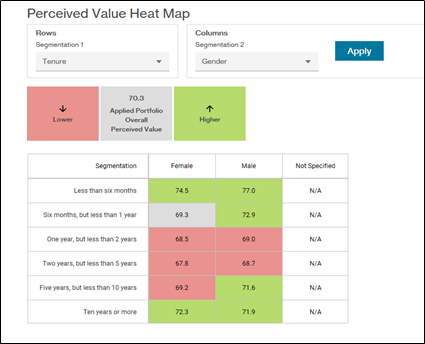You can read a long interview I did with People Matters magazine here:

Nick Lynn PhD

Here’s the latest version of my informal newsletter, containing a short selection of the very best EX articles I’ve come across over the last few months (so you don’t have to slog through LI or Twitter).
First up is a terrific HBR article by Diane Gherson and Lynda Gratton on how overwhelmed many managers are and what to do about it. In our data we’re seeing more and more evidence of manager burnout. It’s often a systemic problem that’s fixed by rethinking the role of people leader. There is some great advice in this piece: building people leadership skills, simplifying work, and job redesign. Related to this, I am working on a number of “Manager 180s” for clients at the moment that provide tailored developmental feedback to people leaders at all levels. It’s a great use of our listening platform (and often not part of a traditional “listening strategy”).
https://hbr.org/2022/03/managers-cant-do-it-all
I’m a long-time fan of Joe Pine and Jim Gilmore, the authors of The Experience Economy, one of my favourite books. I really like their latest article on transforming jobs to create more compelling employee experiences. Too much of the discussion about the Future of Work focuses on automation, cost-saving, and efficiency (the transactional side of work). It’s good to be reminded of the opportunity to invest in people, engagement, and trust (by transforming jobs).
This is an interesting article by Ayelet Fishbach on how moderate emotional discomfort can be a signal that you’re developing as a person. It often happens before you can actually detect the benefits of self-growth. In other words, short-term discomfort can be a sign you’re making progress towards long-term gains. Ayelet is author of the book “Get It Done: Surprising Lessons from the Science of Motivation”.
The final pair of articles are both reflections on what has happened over the last 2-3 years:
Here, Eric McNulty focuses on leadership. He sets out a simple process of “sensing-responding-adapting” in order to be agile enough to respond to uncertainty and shocks. I think it’s a very powerful (and simple) framework:
And here Gethin Nadin asks how you design employee experiences starting from the premise of needing “more conscious and compassionate workplaces”:
https://www.hrzone.com/engage/employees/employee-experience-and-the-rise-of-compassionate-capitalism
As always, let me know what you think!
Nick
I did a Live Stream on PAFOW Live with Al Adamsen on employee experience architecture. You can watch it here:

I’m helping several companies at the moment review employee feedback from surveys and virtual focus groups and the like. On top of everything else, there are a couple of clear issues leaders are facing:
First, an innovation challenge. That might sound odd, given all the change & disruption of the last 18+ months. But a lot of those things were already in the works – they’ve mainly been accelerated. Breakthrough and disruptive innovation, which rely on collaboration and risk-taking, have been far harder to achieve. I think this is mainly due to organisations operating in a Survive State. There has been a narrowing of focus as a result. A key question for leaders is how to return to a more open innovation mindset and quickly.

Second, a growing wellbeing concern. This is not a surprise, but the sustained slog of the pandemic really is taking a toll on all aspects of wellbeing: physical, social, emotional. As a result, some people have reconsidered their working life priorities. This re-evaluation combined with sustained anxiety is one of the dynamics behind the high turnover many companies are facing. Putting deep and culture-based strategies in place to address wellbeing challenges is critical in order to support people and minimise the risk of losing key talent.


The field of of people analytics has seen rapid growth over the last years. As someone who has explored the links between people and performance throughout my career, it’s been great to see this explosion of interest.
There are various definitions of people analytics, which is sometimes called HR analytics or workforce analytics. Janet Maher and John Boudreau call it “An evidence-based approach for making better decisions on the people side of the business; it consists of an array of tools and technologies, ranging from simple reporting of HR metrics all the way up to predictive modelling.”
Jonathan Ferrar and David Green in their book Excellence in People Analytics emphasise the importance of using people data to provide business value. They describe different ages in the evolution of the field with most companies now focusing on supporting leaders to navigate key challenges: “People analytics is an absolute must-have for any Chief Executive Officer or Chief Human Resources Officer.”
There is a potential hitch in all this progress, however. HR has long been a siloed function and it strikes me that this characteristic is being reflected in the work that is now published and shared in the people analytics community. Recent people analytics books, collections, conferences, and articles all seem to have a glaring gap; hardly any of them make any mention of rewards.
Recent people analytics books, collections, conferences, and articles all seem to have a glaring gap; hardly any of them make any mention of rewards.
There are a few notable exceptions. There has been some great work looking at gender and ethnicity pay gaps, for example. It’s also true that, because of the nature of rewards work, it can be harder to share the outputs in public. But in the main, reward analytics operates as a separate field from people analytics, just as rewards is usually a separate sub-function from talent. Even though rewards is full of data-savvy and analytically-minded people. This feels like a missed opportunity.
That’s because decisions about rewards are important business ones. Payroll is a significant percentage of revenue. Companies source and offer a complicated mix of pay, incentives and benefits. It’s an area where smart analytics can provide a lot of business value and generate a return on investment.
Reward design choices are also important human decisions. Rewards carry emotional as well as practical weight. A lot of organisational energy is spent discussing them. And incentives affect behaviour, often in oblique ways.
Getting total rewards right can mean the difference between competing effectively in the global talent marketplace and being left behind. A consumer-grade total rewards portfolio of pay, benefits, wellbeing and career programmes serves as a catalyst, driving attraction, retention and engagement of talent essential to business success. Yet, in many organisations, total rewards are not evolving quickly enough to keep pace with changes in the world of work.
All of this underlines that when it comes to employee experience (EX), rewards obviously matter. It’s why in our work we include total rewards as one of the four key dimensions of a High-Performance EX, as shown below:

Let me expand on this point about employee experience. I have written quite a bit about EX, and one of the things I believe strongly is that EX requires a shift in perspective. In essence, it means moving away from a traditional and top-down view of organisations towards a messy, conversational, and more personal view of life at work.
From an EX point of view, therefore, all the following things are super-interconnected: jobs, work, performance, skills, careers, learning, pay, benefits, inclusion, engagement, well-being, communications, culture…
It’s a blatantly obvious point, but worth stating — employees don’t experience life at work through a HR lens. Rather, HR needs to think about organisational effectiveness from an employee perspective. That’s the fundamental trick in making EX work.
The same logic applies to people analytics. Talent metrics only address part of the humans and work equation. If you exclude rewards, you’re not capturing the whole picture and you’re not thinking systemically.
Talent metrics only address part of the humans and work equation. If you exclude rewards, you’re not capturing the whole picture and you’re not thinking systemically.
So what does it look like to bring reward into people analytics? One example is the work we do around optimisation. Specifically, Total Rewards Optimisation (TRO) allows you to align reward investments with the employee experience. We talk about finding the “sweet spot” — the intersection that aligns what and how much you spend on total rewards with what your employees value most and least across what you offer — while uncovering how reward changes affect employee behaviour and performance on the job.
There are four key parts to TRO:



To my mind, TRO is a great piece of people analytics. It’s got interesting and important data, cool maths, fun modelling, nice data visualisation. More importantly, you’re linking together employee preferences and behaviours to business and financial data in order to understand trade-offs and ROI. And those scenarios are typically explored interactively with leaders as different hypotheses are tested and analysed.
My broader argument, however, is that this is an example of how it’s possible to include rewards in people analytics and that this is an important thing to do. It’s one thing to look at engagement, retention and performance drivers for your key talent, and to make decisions based on that data. It’s another to look at those things alongside what you spend on total rewards and how you shape, customise and communicate your value proposition. The latter is taking a step towards thinking holistically about employee experience.
This is especially important right now as leaders are acutely aware of the importance of retaining and attracting key talent in the midst of a period of high turnover. Rather than throwing money at a problem, finding the sweet spot matters more than ever.
There’s also a point here about the state of people analytics at the current time. It’s possible to see the recent rapid growth in people analytics as a transitory moment. A point when data became more available and HR began to explore how it can be used for improving decision making. At first, growth in analytics has mostly occurred with a traditional HR mindset, within HR silos, reflecting long-held budgets and distinct backgrounds and skillsets. But in the near future, the picture might look quite different. As datafication continues apace, the current people analytics community may merge with others to become the analytics engine of an EX function or even an EX analytics team within a business intelligence function. In some of my clients, this shift is already happening.
As datafication continues apace, the current people analytics community may merge with others to become the analytics engine of an EX function.
Jonathan Ferrar and David Green also refer to this kind of transition in their recent book, as they herald a new Age of Excellence in people analytics where “the human resources function itself becomes even more data literate.”
A key question for me is whether that means “business as usual” (such as continuing to think in HR terms) or taking a leap and embedding analytics and design thinking within a truly EX mindset.

Here is the autumn edition of my EX Newsletter.
Over the last few months, we have been doing a lot of work on the connection between culture and EX, and that’s reflected in the content below. Both topics are top of mind for many leaders I’m working with. I think this is because there are just so many things happening that are impacting trust at work – witness “The Great Resignation” – that it’s important to reflect on key principles about purpose and alignment.
John Kotter’s new book Change is one of my favourites of the year and I highly recommend it. He incorporates research from neuroscience with his long-standing focus on organisational culture and change. This article is a useful summary of his approach: https://sloanreview.mit.edu/article/overcoming-obstacles-to-successful-culture-change/
I like this idea of “a people-centered operating system” from Vivek Sharma, with a focus on goal setting, learning, and culture. In this short article, he argues that the future of work is really about the future of talent, which is something I strongly agree with: https://www.entrepreneur.com/article/376749
I am very interested in new and different sources of EX data, so Culture X’s research into Glassdoor reviews is something I’ve been following closely. This is another great article from them, which highlights the fundamental importance of respect and leadership: https://sloanreview.mit.edu/article/10-things-your-corporate-culture-needs-to-get-right/#EmployeeExperience
My colleague John Bremen has written a series of terrific articles on human capital issues and I really enjoyed this one on “workplace dignity”. He talks about dignity at work, dignity in work, and dignity from work: https://www.willistowerswatson.com/en-GB/Insights/2021/09/reducing-talent-risk-through-workplace-dignity
I hope you find these articles useful; let me know!
Nick
Here is the Summer edition of my EX newsletter; a selection of the key EX articles I’ve come across over the last few months.

Why Trust Is the Future of the Employee Experience
So much has been written about EX and making hybrid working work! But I really like this short and optimistic article by Gethin Nadin. “One of the biggest lessons businesses learned from the pandemic was that employees can be trusted. As we begin to recover and prepare for new ways of working, it’s critical for employers to sustain this trust and build an employee experience founded on autonomy and choice.”
https://www.hrzone.com/engage/employees/why-trust-is-the-future-of-the-employee-experience
Should HR Adopt the “Noise Audit”?
Daniel Kahneman’s new book Noise (about the variability of human judgement) has been getting a lot of press. In this short LI piece, Anna Tavis asks “What does it mean for HR?” and concludes “We may consider adding the “noise audit” to our organizational tool kit and revisit our relationship with algorithms as partners on the people experience journey.”
https://www.linkedin.com/pulse/should-hr-adopt-noise-audit-anna-a-tavis-ph-d/
The Pandemic Did Not Affect Mental Health the Way You Think
This was a really interesting article in The Atlantic. The pandemic has led to real struggles for many people and many companies (also see below), but at the same time there has been an astonishing degree of resilience, which in itself holds key lessons.
The Great EX Stress Test
We have been busy with new WTW research. We have just published the results of a major external survey of employee experience. The pandemic has put many organisations under stress and we have looked at those companies that have been able to respond the best, because they have a transformative approach to EX. I have put some of our slides here if you’d like to see them (hot off the press!)
https://www.linkedin.com/smart-links/AQGVP983fY2w3w
I have also written a couple of articles recently: The first is about how UK companies have responded to the FRC changes on board oversight of employee engagement. The second is on why co-creation and involvement are at the heart of EX activation.
https://exleadership.com/employee-engagement/
https://exleadership.com/co-creating-your-employee-experience-strategy/
Any questions or comments or feedback, drop me a note!
Take care,
Nick

Hello!
A number of people have asked me to start an informal EX newsletter containing the key articles that I come across. I post and share a lot, but social media can feel like overload, and I was asked if I can provide a kind of filter. So every couple of months I plan to share 3-4 recommended articles. I will share the ones that contain really great insights or new thinking.
EX Newsletter 1st March 2021
Why you should apply design thinking to the employee experience
This article contains a great list of principles for how you think about designing EX: Segments, promises, innovation, coherence, and efficiency. “COVID-19 has forced changes in the way people work and created a once-in-a-generation opportunity to increase engagement and productivity.”
New Context, New Leadership: The 5Cs
This is one of the best articles I’ve seen on the changing context for leadership during and coming out of this pandemic. “A new Leadership permeated with Care, Cause, Collaboration, Creativity and Courage.”
When Employees Speak Up, Companies Win
This is an excellent article on speaking up. One of the things I write about in my book is how many employees “default to silence”. You have to work hard to capture employee voice. When you do, as this paper shows, everyone can win.
What is Employee Experience (EX)?
ICYMI, I have also included a link to one of my most popular blogs. I think the reason it’s popular is that everyone’s talking about EX, but there are a lot of different meanings. So I attempt to provide a definition.
——————————————————–
That’s all for this edition. If you have feedback or if there are specific EX topics you’re interested in and would like me to look out for, let me know.
Best wishes,
Nick
Tags: #EmployeeExperience #Leadership

A CEO I’m working with told me their 3 “big worries” about their people during this pandemic:
1. All the “pre-activity” (their word) that’s being lost, i.e. the chance conversations and the informal sharing of information and insight that usually takes place in the office.
2. The lack of mentoring and day-to-day coaching of junior staff – again the informal stuff where people are shown new things or learn a different perspective.
3) The difficulty that leaders are having in “instilling and sustaining” (their words) the culture of the organisation “over Teams.”
It could be that a lot of this is happening online and simply isn’t visible to leaders, which is one of the things we’re looking to find out. But I also think these are important concerns.
In fact, many of the leaders I’m working with at the moment are asking something similar, along the lines of “How do we maintain connection and belonging and evolve our culture as we work differently?” Or as another client put it: “As this pandemic goes on and on and on… how do we keep and evolve the “secret sauce” that’s made us successful?”
Connection, belonging, innovation… these are key reasons for focusing on the changing employee experience.
Tags: #COVID #EmployeeExperience